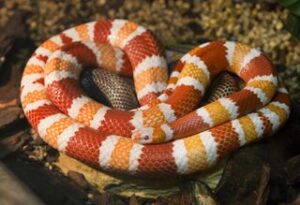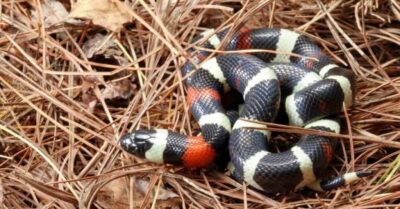Are milk snakes good pets? This question often arises among reptile enthusiasts and prospective pet owners. Delving into the world of reptile companionship can be both exciting and daunting, especially when considering a species like the milk snake.
Milk snakes are often considered excellent pets for reptile enthusiasts. With their vibrant colors, relatively small size, and manageable care requirements, milk snakes can be rewarding pets for both beginners and experienced keepers alike.
However, like any pet, they require proper care and attention to thrive. In this guide, we’ll explore the characteristics, care needs, and considerations for keeping milk snakes as pets to help you determine if they are the right choice for you.
Characteristics of Milk Snakes

Milk snakes are nonvenomous snakes belonging to the genus Lampropeltis. They are known for their vibrant colors and are often confused with the venomous coral snake due to their similar coloration. Here are some characteristics of milk snakes:
- Coloration: Milk snakes typically have brightly colored bands of red, black, and yellow or white. The order of these bands can vary depending on the subspecies.
- Size: They are relatively small to medium-sized snakes, with adults typically ranging from 20 to 60 inches (50 to 152 cm) in length, depending on the species.
- Habitat: Milk snakes are found in various habitats throughout North and South America, including forests, grasslands, and rocky areas.
- Diet: They are constrictors and primarily feed on small rodents, such as mice and rats. They may also eat birds, eggs, and other small vertebrates.
- Behavior: Milk snakes are generally docile and non-aggressive. When threatened, they may vibrate their tails, release musk, or bite as a defense mechanism.
- Reproduction: They are oviparous, meaning they lay eggs. Females typically lay clutches of 3 to 24 eggs in warm, hidden locations. The eggs hatch after about 60 days.
- Subspecies: There are many subspecies of milk snakes, each with its own unique coloration and distribution. Some of the most well-known subspecies include the Eastern milk snake (Lampropeltis triangulum triangulum) and the Honduran milk snake (Lampropeltis triangulum hondurensis).
Are milk snakes good pets?
Milk snakes can indeed make good pets for the right person. Here’s a breakdown of what makes them suitable as pets:
- Size: Milk snakes are generally small to medium-sized, which makes them easier to handle and care for compared to larger snake species. They typically range from 2 to 4 feet in length, with some subspecies growing slightly larger.
- Temperament: Milk snakes are usually docile and non-aggressive, especially if they are captive-bred and properly socialized. They are known for their calm demeanor, which makes them suitable for beginner snake owners or families with children.
- Easy to care for: These snakes have relatively simple care requirements. They need a properly sized enclosure with appropriate temperature and humidity levels. They primarily eat rodents like mice or rats, making feeding relatively straightforward compared to some other reptiles.
- Variety of colors and patterns: Milk snakes are famous for their vibrant colors and striking patterns, which can vary depending on the subspecies. Their beautiful appearance can be a significant draw for reptile enthusiasts.
- Long lifespan: With proper care, milk snakes can live for more than 10 to 20 years in captivity, sometimes even longer. This long lifespan allows for a meaningful and long-term pet relationship.
However, there are also some considerations to keep in mind before getting a milk snake:
- Housing requirements: Milk snakes need a secure enclosure with appropriate temperature gradients and humidity levels. Setting up the right habitat can require some initial investment in terms of equipment and setup.
- Feeding habits: While feeding them is relatively simple, some people may be uncomfortable with feeding rodents to their snake. Additionally, some milk snakes can be picky eaters or may have specific dietary requirements, so it’s essential to research their feeding habits thoroughly.
- Potential health issues: Like all pets, milk snakes can suffer from health problems, including respiratory infections, scale rot, or parasites. Regular veterinary check-ups and proper husbandry can help prevent these issues.
- Legal considerations: Always check local laws and regulations regarding keeping snakes as pets. Some jurisdictions have restrictions on owning certain species of snakes, including milk snakes.
Overall, milk snakes can be rewarding pets for responsible owners who are willing to provide the necessary care and attention. As with any pet, it’s crucial to research their needs thoroughly and ensure you can meet them before bringing one home.
Types of food milk snakes eat
Milk snakes are carnivorous reptiles, and in the wild, they primarily feed on small mammals, birds, bird eggs, and sometimes other reptiles. In captivity, they are typically fed a diet of appropriately sized rodents. Here are the types of food commonly fed to milk snakes:
- Mice: Mice are the most common food for captive milk snakes. They should be appropriately sized for the snake’s age and size. Pinky mice (newborn mice) are suitable for hatchling milk snakes, while larger adults may eat adult mice or even small rats.
- Rats: As milk snakes grow, they can be fed larger prey items like rats. Just like with mice, it’s essential to choose the right size rat for the snake’s size and age.
- Fuzzies and Hoppers: These are slightly larger than pinky mice but smaller than adult mice. They are suitable for juvenile milk snakes.
- Thawed Frozen Prey: Many snake owners prefer to feed their snakes thawed frozen rodents rather than live prey. Thawed frozen rodents are safer for the snake and easier to store.
It’s essential to ensure that the prey items are appropriately sized for the snake to prevent choking or regurgitation. Additionally, providing a varied diet can help ensure that your milk snake gets all the necessary nutrients. However, it’s crucial to avoid feeding them wild-caught prey, as it can introduce parasites and diseases to your snake.
Typical temperament of milk snakes

Milk snakes are generally known for their docile and calm temperament, which makes them popular among reptile enthusiasts, including beginners. Here are some typical temperament traits of milk snakes:
- Docile: Milk snakes are usually non-aggressive and tolerant of handling, making them suitable pets for beginners and experienced reptile keepers alike.
- Curious: They are often curious by nature and may explore their enclosure when given the opportunity. This behavior can make them interesting and entertaining pets to observe.
- Handleable: With regular, gentle handling, milk snakes can become quite tame. They are generally comfortable being handled and may even enjoy interacting with their owners.
- Rarely defensive: While all snakes have the potential to bite if they feel threatened, milk snakes are not generally defensive. They are more likely to retreat or try to hide rather than display aggressive behavior.
- Easy to socialize: When properly socialized from a young age, milk snakes can become very accustomed to human interaction. Regular, gentle handling helps to build trust between the snake and its owner.
However, it’s important to remember that individual temperament can vary from snake to snake, so it’s always a good idea to approach any snake with caution until you’re familiar with its behavior. Additionally, even the most docile milk snake may become defensive if it feels threatened or stressed, so it’s essential to handle them gently and respectfully.
Potential risks of handling
Handling a milk snake is generally safe, but there are still potential risks that owners should be aware of:
- Bites: While milk snakes are generally docile, they may bite if they feel threatened or stressed. Although their bites are usually not harmful to humans, they can cause minor puncture wounds or scratches.
- Stress: Handling can be stressful for snakes, especially if they are not accustomed to it or if they are handled too frequently. Too much stress can weaken their immune system and make them more susceptible to illness.
- Regurgitation: Handling a snake too soon after it has eaten can cause it to regurgitate its meal. This can be harmful to the snake and should be avoided.
- Escape: Milk snakes are adept at escaping from their enclosures, especially if they are not securely latched. Handling a snake outside of its enclosure increases the risk of escape.
To minimize these risks, it’s essential to handle your milk snake gently and with care. Here are some tips for safe handling:
- Wash your hands: Always wash your hands before and after handling your snake to prevent the spread of bacteria.
- Handle with care: Support your snake’s body properly when handling it to prevent injury and stress.
- Avoid handling after feeding: Wait at least 48 hours after your snake has eaten before handling it to prevent regurgitation.
- Watch for signs of stress: If your snake shows signs of stress, such as rapid breathing, hissing, or attempting to flee, gently return it to its enclosure and give it some time to relax.
By following these guidelines, you can minimize the risks associated with handling your milk snake and enjoy a positive interaction with your pet.
Handling tips and techniques

Handling your milk snake can be a rewarding experience for both you and your pet. Here are some tips and techniques to ensure safe and enjoyable handling:
- Wash your hands: Before and after handling your snake, wash your hands with warm, soapy water to remove any bacteria or other contaminants that could harm your pet.
- Approach calmly: When you’re ready to handle your milk snake, approach it calmly and confidently. Sudden movements or loud noises can startle your snake, so it’s best to move slowly and deliberately.
- Support the body: When you pick up your snake, support its body with both hands. Use one hand to support the front third of the snake’s body and the other hand to support the middle third. Avoid squeezing or pinching your snake, as this can cause it stress.
- Be gentle: Handle your snake gently and with care. Avoid jerky movements or sudden changes in direction, as this can startle your snake and cause it to become stressed.
- Watch for signs of stress: While handling your snake, watch for signs of stress such as rapid breathing, hissing, or attempting to flee. If your snake becomes stressed, gently return it to its enclosure and give it some time to relax.
- Start slowly: If your snake is not used to being handled, start with short handling sessions and gradually increase the length of time as your snake becomes more comfortable.
- Avoid handling after feeding: Wait at least 48 hours after your snake has eaten before handling it to prevent regurgitation.
- Handle regularly: Regular handling can help your snake become more accustomed to human interaction and can strengthen the bond between you and your pet.
By following these tips and techniques, you can ensure safe and enjoyable handling sessions with your milk snake. Remember to always be patient and gentle, and respect your snake’s boundaries.
Common health issues in milk snakes
Milk snakes, like all reptiles, are susceptible to a variety of health issues. While they are generally hardy animals when provided with proper care, it’s essential to be aware of potential health problems so that you can recognize and address them promptly. Here are some common health issues that can affect milk snakes:
- Respiratory infections: Respiratory infections are common in snakes and can be caused by bacteria, viruses, or fungi. Symptoms may include wheezing, open-mouth breathing, nasal discharge, and lethargy.
- Parasites: Internal parasites such as roundworms, tapeworms, and coccidia can affect milk snakes. Symptoms may include weight loss, diarrhea, regurgitation, and a decrease in appetite.
- Mites: Snake mites are tiny parasites that can infest a snake’s skin and cause irritation, anemia, and other health problems if left untreated. Signs of a mite infestation include tiny black or red dots on the snake’s skin, excessive scratching or rubbing against objects, and a decrease in appetite.
- Scale rot: Scale rot is a bacterial infection that affects the scales and skin of a snake. It is often caused by a combination of poor husbandry, such as inadequate humidity levels or substrate that is too wet. Symptoms may include redness, swelling, and ulceration of the skin.
- Mouth rot (infectious stomatitis): Mouth rot is a bacterial infection of the mouth and gums that can affect snakes. Symptoms may include swollen, red gums, excessive saliva, and difficulty eating.
- Injuries: Milk snakes can injure themselves by rubbing against rough objects in their enclosure, getting their heads stuck in tight spaces, or being dropped or mishandled by their owners. Common injuries include cuts, abrasions, and broken bones.
To keep your milk snake healthy, it’s essential to provide it with a clean, well-maintained enclosure, a proper diet, and regular veterinary care. If you notice any signs of illness or injury in your snake, it’s essential to seek veterinary attention promptly.
Early intervention can often prevent minor issues from developing into more serious health problems. Regular health check-ups with a reptile veterinarian can also help to catch any potential health issues early and ensure that your snake remains happy and healthy.
Signs of a healthy milk snake
Recognizing signs of good health in your milk snake is crucial for ensuring its well-being. Here are some signs that indicate your milk snake is healthy:
- Active and alert: A healthy milk snake will be alert and aware of its surroundings. It should move around its enclosure regularly, exploring and investigating its environment.
- Healthy body weight: Your milk snake should have a well-rounded body with a consistent body weight. You should not be able to see its spine or ribs protruding.
- Clear eyes: The snake’s eyes should be bright, clear, and free from discharge or swelling.
- Shedding properly: A healthy milk snake will shed its skin in one complete piece. The shed skin should come off in one continuous piece, including the eye caps.
- Healthy skin: The snake’s skin should be smooth and free from cuts, abrasions, or signs of infection. There should be no signs of scale rot, such as redness, swelling, or ulceration.
- Normal breathing: The snake should breathe quietly and regularly with no wheezing or open-mouth breathing.
- Good appetite: A healthy milk snake will have a good appetite and will eagerly eat its meals. It should be fed an appropriate diet of thawed frozen rodents, and it should have regular, healthy bowel movements.
- Properly hydrated: Your milk snake should have access to clean, fresh water at all times, and it should drink regularly.
- Responsive to handling: When you handle your milk snake, it should be calm and relaxed, with no signs of stress or aggression.
Regular observation and handling of your milk snake will help you become familiar with its normal behavior and appearance, making it easier to recognize any signs of illness or distress. If you notice any changes in your snake’s behavior or appearance, it’s essential to seek veterinary attention promptly.
Pros and Cons of Keeping Milk Snakes as Pets
Keeping milk snakes as pets can be a rewarding experience, but it’s essential to consider both the pros and cons before deciding to bring one into your home. Here’s a breakdown of the pros and cons of keeping milk snakes as pets:
Pros:
- Docile temperament: Milk snakes are generally docile and non-aggressive, making them suitable pets for beginners and experienced reptile keepers alike.
- Low maintenance: Milk snakes have relatively simple care requirements compared to some other reptiles. They need a properly sized enclosure with appropriate temperature and humidity levels, and they primarily eat rodents like mice or rats.
- Beautiful appearance: Milk snakes are famous for their vibrant colors and striking patterns, which can vary depending on the subspecies. Their beautiful appearance can be a significant draw for reptile enthusiasts.
- Variety of colors and patterns: There are many different subspecies of milk snakes, each with its own unique coloration and pattern. This variety allows owners to choose a snake that suits their personal preferences.
- Long lifespan: With proper care, milk snakes can live for more than 10 to 20 years in captivity, sometimes even longer. This long lifespan allows for a meaningful and long-term pet relationship.
Cons:
- Housing requirements: Milk snakes need a secure enclosure with appropriate temperature gradients and humidity levels. Setting up the right habitat can require some initial investment in terms of equipment and setup.
- Feeding habits: While feeding them is relatively simple, some people may be uncomfortable with feeding rodents to their snake. Additionally, some milk snakes can be picky eaters or may have specific dietary requirements, so it’s essential to research their feeding habits thoroughly.
- Potential health issues: Like all pets, milk snakes can suffer from health problems, including respiratory infections, scale rot, or parasites. Regular veterinary check-ups and proper husbandry can help prevent these issues.
- Legal considerations: Always check local laws and regulations regarding keeping snakes as pets. Some jurisdictions have restrictions on owning certain species of snakes, including milk snakes.
Overall, milk snakes can be rewarding pets for responsible owners who are willing to provide the necessary care and attention. As with any pet, it’s crucial to research their needs thoroughly and ensure you can meet them before bringing one home.
Conclusion
Are milk snakes good pets? Milk snakes can make excellent pets for reptile enthusiasts of all experience levels. With their docile temperament, vibrant appearance, and relatively low maintenance requirements, milk snakes are a popular choice among snake owners.
However, potential owners should be aware of their housing, feeding, and health care needs to ensure a happy and healthy life for their pet. With proper care and attention, milk snakes can be rewarding companions for many years to come.

